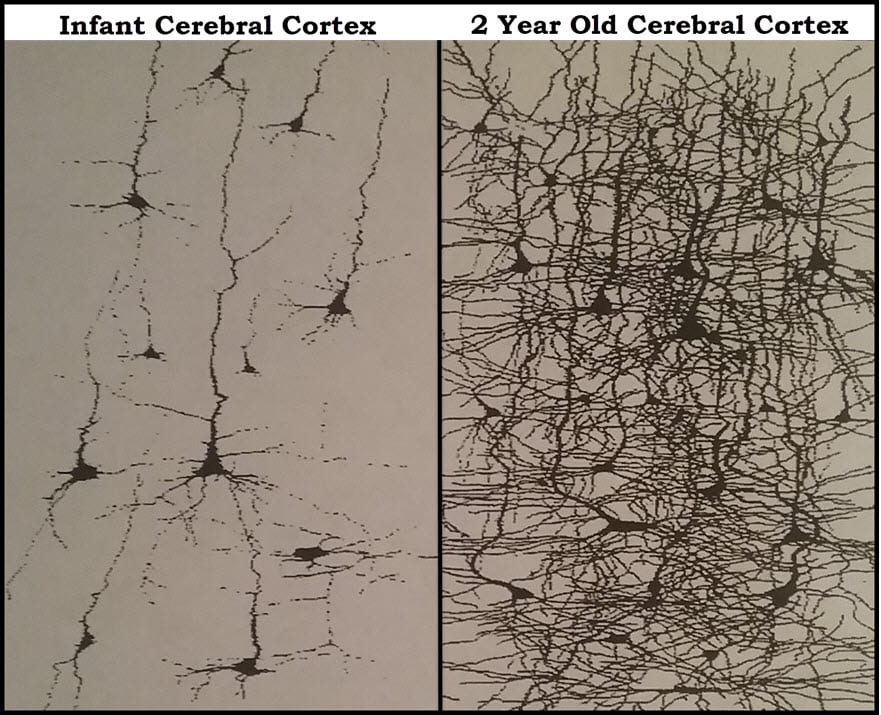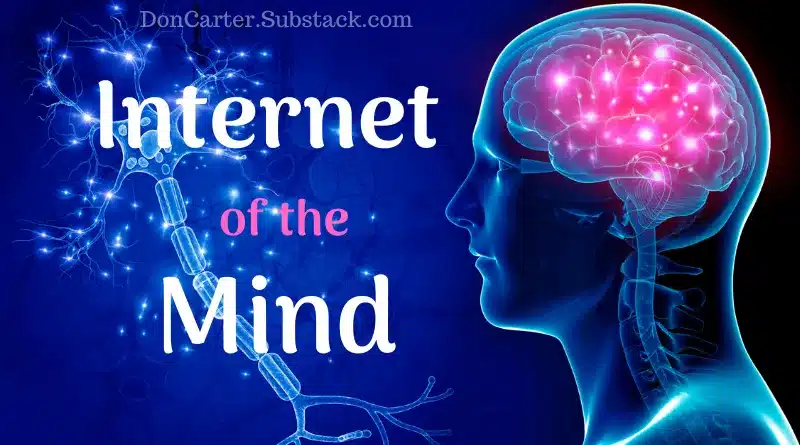
Heebs Law of Neuroplasticity & the Search for Identity
Two hot topics of the day, neuroplasticity and questions of identity, are currently taking center stage in conversations all across the world. A look at the basics of each demonstrates how these topics must be part of the same conversation. Let’s take a look at how, by their very nature, they are woven together in such a way that they may even explain each other. Let’s start here…
What is Neuroplasticity?
Neuroplasticity refers to the brain’s amazing ability to adapt to the internal and external environments it is exposed to over time. This is no longer just a theory, it is backed up by brain imaging technologies such as the one used to capture the images in the video below.
These images help us to see the changing brain in real time. Here we can witness the “Ah Ha” moment when a new thought is encoded on a neural network!
Until now, researchers had to spend a large part of their time justifying the theory of neuroplasticity before they could even present their ideas and findings. Now they can spend that time researching and studying how the brain heals itself, adapts to changing situations and circumstances, and what happens when we “change our minds” about something.
The implications of this ability to rewire the brain are truly staggering. It was not so long ago that the prevailing wisdom was that we are “hardwired” and that, after 30 years of age, change is not very likely. Now that we know that is not the case, new ways of using neuroplasticity are rapidly being developed.
So how does it work? I know it sounds complicated but when you understand how mirror neurons function, it is really very simple and there are only two principles that you need to know in order to make changes in your own brain and nervous system. Those two principles are:
- Neurons that fire together, wire together
- Use-it-or-Lose-it
The video below outlines these two principles of neuroplasticity and is probably one of the most informative six minutes you will spend in your life. As you watch it, keep in mind how interesting it is that your own brain can become fascinated with itself!
Neuroplasticity Principle #1: “Neurons that fire together, wire together”
I said it before and I will say it again, the human brain is the most sophisticated supercomputer in the known universe. Everything we learn is encoded on networks of neurons, embedded in networks of neurons, and so on. These neural networks communicate with each other through electro-chemical impulses.
The electric part of this communication creates what we refer to as brainwave activity. When we are alert and thinking there is a considerable amount of communication taking place which creates brainwave activity in the beta range. When we close our eyes and relax that activity slows down to what we know as alpha-level brainwave activity. When we drop into sleep and rapid eye movement (REM) begins, we are in theta-level brainwave activity.
The deepest level of sleep and the slowest brainwave activity is referred to as Delta-level brainwave activity. If we get into this level of brainwave activity even for only a few minutes, we are lucky. Some say that 10-15 minutes of delta-level sleep results in what we may experience as 8 to 10 hours of deep restorative sleep.
The chemical part of this communication literally creates (manufactures) chemicals known as neurotransmitters (e.g. dopamine, serotonin, etc.) which performs all kinds of functions including the ability to feel good, regulate moods, and learn new things.
Combined electro-chemical activity is what actually occurs when a cluster of neurons “fire together.” the same cluster will fire the same way every time a certain thought or other cognitive activity takes place. The more those clusters fire, the stronger their connections get.
Neuroplasticity Principle #2: “Use-it-or-lose-it”
If the neurons stop firing together for a long enough period of time, the axon and dendrite connections get recruited for new learning elsewhere in the brain. This causes a degradation in the unused neural circuits. The less they fire the weaker the connections get. This is also known as synaptic pruning – a lifelong process of the brain maintaining itself.
Here are some ways to use these principles of neuroplasticity.
- Abstain from addictive thinking and behavior (lose it), replacing it with recovery thinking and behavior (wiring together a new network).
- Abstain from cola, replace it with water or tea
- Abstain from negative self-talk, and replace it with positive affirmations and self-talk.
Neuroplasticity & Synaptic Pruning
The subconscious process of synaptic pruning is thought to be the primary mechanism of learning. The first video above actually shows this process in action. I like to think of it as witnessing the “Ah-Ha!” moment when a new thought is formed and a new neural connection is made. It is very interesting to see the process of changing your mind about something when a connection is deleted. It’s like when we used to believe in fairy tales and monsters… at some point, we just no longer believed that.
Below is an image of neural networks in the brain of an infant compared to those of a 2-year-old.

The brain growth, also known as neurogenesis is staggering! The lifelong process of synaptic pruning begins when neural connections weaken and are no longer needed (use-it-or-lose-it!) Networks that were necessary at one point (nursing) stop firing when that behavior is replaced by eating solid food and drinking from a sippy cup.
I like to think of synaptic pruning as the supercomputer subconscious mind’s way of maintaining and defragging its own hard drive. Pruning unused connections optimize brain functions, keeping it running smoothly and efficiently. (Just think if we were able to do this just as efficiently with our email inbox!)
Neuroplasticity & Chronic Stress
Human beings have two modes of operation: Growth Mode (self-actualization) and Survival Mode (self-preservation.) As a rule, self-preservation trumps self-actualization. When a threat is experienced, real or imagined, the stress response (fight-or-flight) switches on and the energy usually allocated for systems related to growth, health, and nourishment is diverted to the brain for use in responding to the threat.
For example, an 8-year-old girl would have trouble focusing on her multiplication tables in class when she has not had breakfast that morning and all heck broke loose in her alcoholic family the night before. Since she is in survival mode, the energy she needs to focus on the task at hand is not available. Instead, she escapes into fantasy (flight) which has become a habitual survival skill. She may be day-dreaming about being a character in a book she is reading or fantasizing about what it would be like to be part of a happy family like the ones in a movie she saw on TV.
Living in a moderate to severely dysfunctional family puts one in an environment of constant chaos. This, in turn, can create enough chronic stress to keep one in survival mode most or all of the time. When that happens one must develop many survival skills, i.e., many neural networks for survival. These networks get fired whenever enough elements are there to trigger their firing. Every time that happens, the neural network gets strengthened and grows larger.
Intensity and repetition are the mechanisms that create and strengthen these dysfunctional neural networks. Frequent and sometimes unpredictable patterns of chronic stress can be both intense and repetitious. The internal balance (steady-state) can then become one of chaos and dysfunction.
Among the many implications here, is the fact that chronic stress HALTS neurogenesis (brain growth) and therefore stops one from getting or staying on a path of self-actualization. Survival mode becomes the rule which leads to stress-related health conditions (IBS, Chronic Fatigue, etc.,) relationship problems, depression, anxiety, and more! All of this leads to even more chronic stress and the vicious cycle ensues.
Neuroplasticity Gone Wild
The phrase ‘Neuroplasticity Gone Wild’ Comes from a book by Norman Doidge, MD entitled The Brain’s Way of Healing. The first chapter of the book is about Michael Moskowitz, MD who is a chronic pain specialist who had his own bout with more than a decade of chronic pain. Already knowing much about how the brain and the central nervous system process pain, Dr. Moskowitz learned everything he could about neuroplasticity.
The book outlines how Moskowitz used what he learned about the two major principles of neuroplasticity (see the second video above) to create a method to “unlearn” chronic pain. He was pain-free and off all medicines within twelve months of creating his method. Plus, he taught others his method and they replicated his results.
Dr. Moskowitz explains that acute pain is a “bottom-up” signal from the body to the mind telling the brain that an injury has occurred and to be careful so as not to make it any worse. He goes on to explain how chronic pain creates a neural network in the brain when the condition is chronic (because neurons that fire together, wire together.) That neural network grows stronger and larger with intensity and repetition. It becomes a “top-down” signal from the mind to the body.
Right about here is where some people say, “So, you are saying my pain is all-in-my-head!?” NO! Y0ur pain is real and it genuinely hurts! But Moskowitz and others are saying that the primary source of chronic pain is a TOP-DOWN signal that originates in a network of neural networks “in the head” (and is experienced in the body because they are connected.) The SOURCE of chronic pain is in the neural networks that have grown over time. Hence, ‘Neuroplasticity Gone Wild!”
So you might ask what gives the good doctor the right to make such a claim? Because according to his own testimony and the testimony of his patients, Dr. Moskowitz developed and successfully applied a method for ‘unlearning’ chronic pain through the two principles of neuroplasticity noted above. If you are at all interested in learning about more about how to use neuroplasticity in healing the mind and body from chronic conditions (physical or emotional) I highly recommend that you read Dr. Doidge’s book!
Here is a short list of other examples of “neuroplasticity gone wild.” In other words, all of these issues and problems are a result of neurons firing together and wiring together:
- Alcoholism
- Other Addictions
- Codependency
- PTSD
- Treatment-Resistant Depression
- Anorexia
- Work-a-holism
- Anger Management Issues
- Emotional Trauma
- Poor Self-Care
These are just a few examples, but I think you get the idea! We have a neural network for everything we learn – good or bad, functional or dysfunctional.
Neuroplasticity and the Personality
Having been a therapist for the past 30 years has afforded me an opportunity to learn and practice many methods of psychotherapy. I am fond of saying that my clients are my best teachers because no two are alike and what works for one does not always work for others.
I learned early on in my career the truth of the saying, “If all you have is a hammer, then everything looks like a nail.” So I started learning multiple forms of therapy, keeping what worked and discarding the ones that did not bring good results. They call that approach being an “Eclectic” therapist (i.e., knowing and using several approaches to therapy.)
Later I found myself gravitating toward approaches that were not just different, but also complementary. In other words, therapies that could be combined in various ways. I learned that this was called an “assimilative eclectic” approach. I learned and combined clinical hypnosis, ego-state therapy, gestalt therapy, precision CBT, and other Parts-Oriented therapies together in ways that fit the client who was in front of me at the time.
Today, I have settled on one approach — it is called Integrative Psychotherapy and it takes assimilative eclecticism to another level. In addition to the therapies mentioned above, I have added Eye Movement Desensitization and Reprocessing (EMDR) and Internal Family Systems Therapy.
Integrative Psychotherapy is an assimilative eclectic blend of complementary therapy approaches provided on a foundational framework of Erik Erikson’s eight developmental stages of life. Here are my primary approaches:
- EMDR
- Clinical Hypnosis
- Internal Family Systems
- Satir’s Family Systems
- Ego-State Therapy
- Gestalt Therapy
- Precision CBT
- Transactional Analysis
- Twelve-Step Recovery
- Neuro-linguistic Programming (NLP)
These approaches to helping have several things in common. Primarily that they are all based upon the idea that people have many different parts or aspects of self. Also, these parts of self come together to make up a whole system of Self. The system is functional and referred to as integrated when all parts work in harmony together. The system is dysfunctional and considered to be fragmented when parts of self are frequently in conflict with each other or otherwise cause problems in our life when they “get triggered.”
The easiest way to explain fragmented aspects or parts of self is my ceramic baseball analogy: Think of the Self as a ceramic baseball that comes into the world and gets hit by a bat. What happens? The baseball shatters. There is still a large chunk of self that continues to grow and self-actualize, but now there are fragments of self broken off, disconnected from the growing, self-actualizing part and therefore disconnected from all the information, coping skills, and new learning in that part. Here is one example:
An 8-year-old boy walks into a dark room, notices a heavy scent of garlic, the door slams shut, it is pitch black and suddenly he is getting beaten by someone. 30 years later, this same person walks into a dark room, there is a scent of garlic, and the door slams shut — he has a panic attack and reacts from the traumatized 8-year-old fragmented part of the self. He feels 8-years-old, he thinks like an 8-year-old, and he has only the resources that were available to him at 8-years-old. He is disconnected from the core chunk of self that has all of his adult resources and therefore does not have access.
The clinical term for this disconnect is dissociation and it is a sophisticated defense mechanism that helps people, especially children survive something that they might not otherwise have survived. Yes, even these defense mechanisms are encoded on neural networks in the brain. They fire together when triggered in service to the personality as a whole — a survival strategy created and employed by the subconscious mind.
As you may have guessed by now, I like Integrative Psychotherapy because all of these approaches fit with what we now know to be true about neuroplasticity. Parts of self are encoded on neural networks. Some are functional, integrated, and growth-oriented while others may be dysfunctional, fragmented, and survival-oriented neural networks.
All of the above-mentioned approaches help me to have enough flexibility to meet the needs of the client sitting-in-front-of-me AND they allow us to work together on tweaking neural networks with precision like no other methods I have ever found useful.
Even our professional evolution is encoded on a neural network! I have a network of networks for Integrative Psychotherapy that has developed over the past three decades. You also have a network of networks for how to do your job, how to do love, and even how to be YOU!
Neuroplasticity and Implications for Research
Theories about neuroplasticity have been around for a while. But more recently with the advent of brain imaging technologies, it is no longer just a theory. We can now see neuroplasticity in action! (See the first video above) The implications for application and other forms of further research are enormous, especially in this day and age when so many people are struggling to keep up with, make sense of, and understand each other!
Knowing about neuroplasticity can help us tear down barriers, have compassion for each other, make informed decisions, guide us in healing emotional problems, raise healthier children, and even impact policy at the highest levels in the land!
I would have included treatment of addictions to the list above, but the 12-steps model originated by Alcoholics Anonymous has already intuitively and successfully been employing the two principles of neuroplasticity for almost 90 years. All of the elements of addiction are encoded on a network of neural networks in the brain of its carrier. Since all of us are uniquely us, we may manifest those elements in our own way which is why comparing myself with another addicted person is not helpful or advised.
The PROGRAM of any 12-step organization is designed to re-program the thinking, coping, feeling, relating, and even the spiritual functioning of the participant (firing and wiring a new set of neurons together) — while abstaining from people, places, and things associated with the addiction (use-it-or-lose-it).
Neuroplasticity & the Search for Identity
There are so many questions today about who we are and where our identity comes from. Is it genetic? Are we really “born this way?” Or does our identity emerge from the neural networks created by what we dwell on with intensity & repetition?
I believe neuroplasticity holds the key to answering these questions. Looking at the images above comparing the neural matrix of an infant with the neural matrix of a two-year-old suggests we do not have much neuro-circuitry at birth, but that there is an explosion of growth those first two years!
Morris Massey suggests there are three Periods of Child Development. Each period is approximately 7 years long. From ages 0 to 7 years Massey calls the Imprint Period. In this period the child’s brain is like a sponge. Every emotionally significantly intense experience gets imprinted onto a neural network in their subconscious mind. With repetition, these neural networks fire over and over growing stronger connections and expanding the network. This makes most of the learning during this period subconscious.
From 8 to 13 years old is the second developmental period Massy calls the Modeling Period. In the modeling period the child, both consciously and subconsciously, begins to model the behaviors of people around them. Modeling involves pretending, imagination, intensity, and repetition. Kids are very good at imagination. In fact, one of their primary defense mechanisms is fantasy. As they imagine they are that superhero, some of the characteristics of the model gets added to the network being modeled.
They begin to model or emulate the behavior of their heroes and/or people they look up to in their life (with intensity and repetition.) Certain mental filters such as individual values begin to form at this age. The child is only beginning to form a sense of self, an identity of their own. From eleven to thirteen they play around with different roles and different ways of being almost as often easily as changing their wardrobe.
Today, there are no shortages of role models from which to explore. Friends, family, video games, movies, big-screen televisions, the Internet, YouTube, and many, many other influences. The entire world is literally at our children’s finger-tips. And with increasingly high definition technology, the intensity factor is through the roof. The repetition factor in neurogenesis is also increased because many of these technologies tend to be addictive.
At 13 years of age, they enter into the separation and individuation stages of adolescent development. In the individuation stage, the teenager will “try on” different roles like they would a new outfit in order to find the one that best suits them. They may try out being an athlete one day, a musician the next, and a sophisticated intellectual the next day. They may experiment with alcohol or smoking to see how they fit with their emerging personality.
Massey’s Socialization Period is from 14 to 21 years old. During this stage, the developing teenager shifts focus from family to friends. Relationships and social values spring from the adolescent culture of the day. Erik Erikson’s stages of development indicate that the developmental crisis during this period of life revolves around identity vs identity diffusion (confusion.) The current culture of adolescence offers a multitude of identities with which to experiment and explore.
Reputation and image among peers become of paramount importance during this time. Some kids take refuge in the stance that, “I fit in all groups” freely moving from one group to another rather than making a commitment to one group in particular. But in the teen years, because it is important to begin separating from the “apron strings” peer acceptance begins to take precedence, even over the family. Identifying and connecting with a group is the norm for most teens.
Some groups are small and value sameness. Others groups can be very broad and place the value on differentness. Take, for instance, the LBGTQ+ community. The plus (+) was recently added to cover the now two dozen sexual and gender orientations available to an adolescent with which to explore. There are even some orientations just for this purpose. One is called “Bicurious.” Allosexual and Demisexual are also a couple of new orientations.
With identity and neuroplasticity taking center stage at the same time, I think it would be fitting to focus more research into this area. Neurogenesis and neuroplasticity appear to this writer much a more likely explanation for the question of identity than the simplistic explanation “I was born that way.” ESPECIALLY since the latter explanation presupposes that the brain not only comes into the world “hardwired” but remains hardwired throughout the life cycle — something that is totally antithetical to the whole concept of neuroplasticity.
Why is More Research Important?
I am not advocating more research to take a side, prove a point, or advance a narrative. In my opinion, it does not really make much of a difference whether identity is genetically programmed, or a consequence of firing a set of neurons over and over again. Identity is identity and EVERYONE has a right to self-determination, compassion, and to be treated respectfully.
I am advocating for more research (and lots of it) for the children. They are the ones being left out of the conversation and over 100 years of child development research is being tossed aside like so much wasted paper without a second thought. Kids are being exposed to decisions about who they are WAY TOO EARLY in life.
One thing we do know for sure about identity — it is NOT static. Identity is in a constant state of flux throughout the life cycle and especially through the stages of child development. The primary task of adolescence is answering the question “Who am I?” And yet children are being given puberty-blocking drugs before adolescence even has a chance to start. Click here for a summary of 12 known studies on how many kids actually stay transgender.
It is my understanding that every one of our chromosomes has enough unique information about our bodies to fill 4,000 500-page books! From the color of our hair, the pigment of our skin, our height, bone structure, our immune system, endocrine system, to every cell in our body. And that whole library of information is designed to work together in a synchronized way. Pumping hormones into the mix is destined to have consequences, many of which have already been cataloged: click here for the largest study to date. Again, an adult has a right to choose. But a child is not physically or emotionally ready for such a choice even if they could make a rational, informed decision.
Perhaps the best examples of how children’s best interests are being left out of the conversation come from people who actually grew up in a same-sex marriage. Both of them talk about having two of the best mothers anyone could have — but something was missing.
A Child of Lesbian Parents
Conclusion
If identity really is subject to the principles of neuroplasticity then changing it is possible — right? Not necessarily! There is an old joke that goes something like this: “How many therapists does it take to change a light bulb?” Answer: “Only one, but the light bulb has to really want to change!”
Motivational speaker Wayne Dyer cites 4 criteria for change: “The person has to Really, Really, Really, Really want to change.” It has to be all four really’s, three won’t do it! In recovery from any addiction, it is a well-known principle that the addict or alcoholic has to hit bottom before they can break down the wall of denial to open the door to change. In the book by Norman Doidge, MD entitled The Brain’s Way of Healing (see Above) Dr. Moskowitz points out that a chronic pain patient must be somewhat desperate for a change so that they can be more relentless than the pain when applying the principles of neuroplasticity. For that kind of motivation, it has to be their final resort. They must be sick and tired of being sick and tired.
Even then it is extremely difficult to change an existing neural network, especially at the level of identity. Neural networks for how I define myself have been evolving all of our lives and have become very intricate. In order to change one of these sophisticated and intricate networks, something very intense has to happen. We often hear stories of how an intense near-death experience has been enough to radically change a personality in a single event.
But not every experience can be that intense, so it must also be repetitious (practice makes perfect). Let’s take, for instance, the alphabet which we began to learn in first grade. In the USA they made a song out of it called “My ABC’s” so children could sing it repetitiously and the music made it less boring, if not more intense. Next, we had all those spelling tests, then we had to learn grammar, do book reports, study language arts, etc. All of this so we could benefit from education – Everything else we did involve reading and writing. Even in the workforce, after graduation, we had to use those skills and still do to this day.
So what has a lifetime of using the alphabet gotten us? Many of us have read a popular social media post of a paragraph with all of the letters in each word were jumbled, except for the first and last letter, and we were amazed to see that we could read the paragraph fluently. (By the way, isn’t it interesting that our brains can amaze themselves?) For some reason the post is no longer able to be embedded here due to privacy settings, but the following was found in a search on Bing Search engine:
“According to research conducted at Cambridge University, the phenomenon known as Typoglycaemia demonstrates that our brains can read jumbled words as long as the first and last letters are in the correct places. The rest of the letters can be a total mess, and we can still read the text without any problem. This intriguing ability arises because our minds don’t read every letter individually; instead, they process words as a whole. Let’s delve into the details:
- The classic internet trivia meme you’ve likely encountered claims that if the first and last letters of a word are correctly placed, the order of the other letters doesn’t matter.
- While there never was a Cambridge researcher behind this meme, there is scientific reasoning behind why we can read such jumbled text.
- In 2011, researchers from the University of Glasgow discovered that our brains predict what they expect to see based on context, memories, and other senses. Essentially, our minds construct a complex jigsaw puzzle using any available pieces. When something is obscured or unclear visually, our brains fill in the gaps.
- The original demonstration of letter randomization dates back to Graham Rawlinson, who conducted experiments in 1976. His findings revealed that people could recognize words even if the middle letters were jumbled. However, there are some caveats:
- Short words are easier to decipher due to fewer variables.
- Function words (like “and,” “the,” and “a”) tend to remain unchanged because they’re so short, preserving the sentence structure.
- Switching adjacent letters (e.g., “porbelm” for “problem”) is easier to interpret than more distant letter switches (e.g., “plorebm”).
- So, while the Cambridge researcher claim isn’t entirely accurate, our brains indeed have fascinating ways of processing language!”
The neural network that started out learning to sing the ABC’s has become so advanced that it no longer has to read every letter! Why can only 55% of people read this? Probably because the other 45% are too young to read or were never taught how. So what would it take for me to use neuroplastic principles successfully to unlearn the alphabet? I would probably have to refuse to read, write, or utter words (use-it-or-lose-it) AND I would have to learn and practice a new way to communicate such as signing a foreign language (firing a new set of neurons over and over.) Even then, it would take decades of discipline and hard work to unlearn an advanced network such as this.
The neural networks of how-to-be-me are also very advanced!
People who are happy with their identity will possess neither the motivation or the inclination to apply neuroplastic principles for change. In fact, they might even be insulted at the implication that they should change. And why not? They have made peace with who they are. But that does not mean they can’t change — and it does not take much digging at all to find an incredible number of people who actually HAVE changed advanced neural networks.
A few decades of alcoholism creates an advanced neural network. Yet, we know that millions of alcoholics have changed what was once believed to be “unchangeable” — They are sober. Was it simple? NO, not simple. But they do say it’s easy – All you have to do is change your whole life! Anyone who has experienced the gift of recovery will tell you that initially, they could not even fathom life without alcohol. After a considerable amount of time, intensity, and repetition those same people will say they have gone years without even thinking of a drink.
The same is true of hundreds of other addictions, obsessions, and compulsions. and then there are codependent patterns and Adult/Child Syndrome. But these are dysfunctional neural networks that cause problems and pain in our lives, eventually enough pain to motivate us for change. Pain seems to be a requirement for the energy and motivation to even consider changing.
So once we have enough pain and we are ready to consider changing, how do we go about it? The Neuro-linguistic Programming (NLP) Logical Levels of Change coupled with the principles of neuroplasticity above are a good place to start.
FINAL NOTE: How do we get along when our personalities clash? We must extend to each other what we expect from each other. If I expect you to accept me as I am, then I must accept you as you are. We must stop trying to force each other to submit to the way we believe things “should” be. Stop ‘Shoulding’ on each other, come together were we can and agree-to-disagree when we can’t. Self-determination must go both ways.




